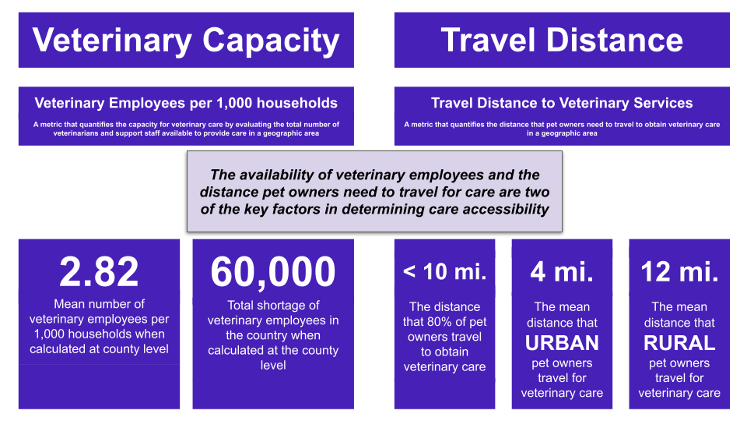Veterinary Care Deserts: What Is the Capacity and Where Is It?
DOI:
https://doi.org/10.56771/jsmcah.v1.2Keywords:
access to vet care, veterinary care desert, distance to veterinary clinic, care desert parameters, veterinary care desert definitionAbstract
Introduction: Access to veterinary care is a complex issue that lies at the intersection of socioeconomics, culture, and space. Although there has been substantial research that has explored factors that impede access to care, the issue has not been well addressed from a geographic perspective. Access deserts is a familiar concept that has been applied to human health care, access to nutritious foods, etc. Thus, there is value in conceptualizinsg access to veterinary care through the same lens. This research aims to advance the effort of identifying veterinary care deserts by specifying normative values for two fundamental parameters: the ratio of care providers to measures of the population and the catchment of clinics.
Methods: Total employees at veterinary clinics were aggregated at the county level and normalized by different measures of human and companion animal population. All clinic employees are included under the assumption that increased support staff increases the overall care capacity. Weighted means were generated and reported for each approach. The number of veterinary clinic employees needed in each county in order to reach the weighted mean for the overall country is also reported both at the county level and state level. Clinic catchment was measured by evaluating the mean distance traveled using data from a large number of clinics and clinic clients. The data were further analyzed using Rural Urban Commuting Areas (RUCA) classifications.
Results: Veterinary employee shortages were observed ranging from 20,000 to 60,000 employees depending on how the data are viewed. Parameters for the weighted mean number of employees were reported in a detailed chart. Results of the distance analysis indicate that most people travel between 2 and 6 miles to reach clinics.
Conclusion: This research indicates spatial disparities in the distribution of veterinary staff. The parameters of the ratio of employees to population measures and distance traveled can both be used in future research that aims to identify local and regional veterinary care deserts. This analysis could be further enhanced by the addition of factors such as socioeconomic data or social determinants of health to further define and identify care deserts.
Downloads

Published
How to Cite
Issue
Section
License
Copyright (c) 2022 Sue M. Neal, Mike J. Greenberg

This work is licensed under a Creative Commons Attribution 4.0 International License.








